The reduction of the number of parameters was achieved through the substitution of AFGEN tables with crop–specific functions. Two approaches were used to replace AFGEN tables. In case of negligible variability among available rapeseed parameterizations, AFGEN tables were replaced by non–editable functions which interpolate their trends. Following this principle light-use efficiency of individual leaves (EFFTB), extinction coefficient of visible diffused light (KDIFTB) and reduction factor due to senescence of maintenance respiration (RFSETB) were substituted with constant values, whereas other AFGEN tables required the definition of non-editable functions. It is the case of reduction factors of gross assimilation rate (TMNFTB; function of minimum night temperature; unitless, Equation 1); relative rate of stems death (RDRSTB; function of DVS; kg kg-1 d-1, Equation 2); relative rate of roots death (RDRRTB; function of DVS; kg kg-1 d-1, Equation 3) and biomass partitioning to roots (FRTB; function of DVS; kg kg-1, Equation 4).
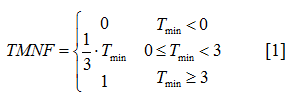
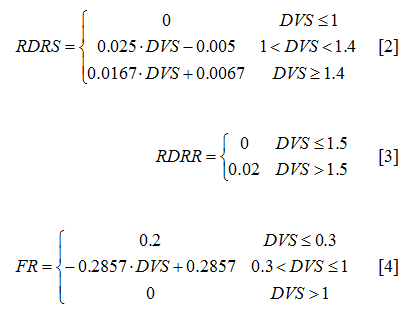
The second approach was applied to the remaining AFGEN tables, which highlighted marked differences among available parameterizations. It consisted in the introduction of functions able to reproduce the shape of the AFGEN parameterizations proposed by different Authors and in the identification of few driving parameters, in order to allow the user to modulate the physiological crop responses to air temperature or DVS. The identification of these parameters was carried out with the aim of providing them a clear physiological meaning, in order to ease their calibration through field experiments or literature survey. Following this approach, the AFGEN tables DTSMTB (function of daily average temperature; °Cd) and TMPFTB (function of daily average temperature; °Cd), respectively related to the effect of temperature on thermal time accumulation rate and CO2 assimilation, were substituted by a β function (Yin et al. 1995; Equation 5 and 6) driven by three parameters: minimum (Tb), optimum (To) and maximum temperature (Tc).
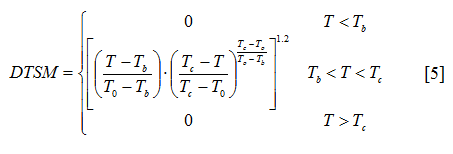
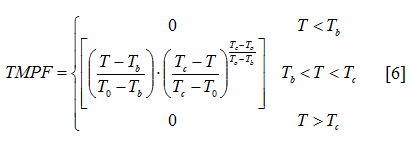
AFGEN tables related to biomass partitioning were substituted with (i) a logistic function (Equation 7) driven by partitioning to kernels at maturity (FOmat) for the simulation of partitioning to storage organs (FOTB, function of DVS; kg kg-1) and (ii) a parabolic function (Equation 8) driven by biomass partitioning at emergence to leaves (FLem) for partitioning to leaves (FLTB, function of DVS; kg kg-1).


The AFGEN describing specific leaf area (SLATB, function of DVS; ha kg-1) was substituted with a linear equation (equation 9) driven by specific leaf area (SLA) at emergence (SLAem). This parameter also determines the angular coefficient of SLA function (Equation 10).
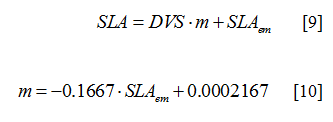
A particular case is represented by AMAXTB (function of DVS; kg ha-1 h-1), the table determining the maximum rate of CO2 assimilation as a function of DVS. All the available rapeseed parameterizations highlight a local minimum of AMAX during the flowering stage (Figure 1): this trend in maximum leaf assimilation rate, however, does not represent a change in physiological characteristics of the leaves, but it roughly represents the decrease of photosynthesis caused by the shading effect of inflorescence (Muller et al., 2005). The adoption of a new distribution of CPAI (see Section 2.32.2) allows to explicitly account for light interception by inflorescence, which lowers the irradiance experienced by the underlying leaves, thereby deleting a trend without any biological meaning. . Moreover, the steep decrease of photosynthesis rates when crop approaches physiological maturity is probably more related to the reduction of the amount of the photosynthetically active surfaces, rather than a change in AMAX of the living tissues. Therefore, a fine calibration of model parameters regulating crop senescence permits to correctly simulate the progression of CAI senescence, which is the major process explaining the slump of photosynthesis during grain filling. For these reasons, in the WOFOST_Rapeseed, AMAX is a constant function during the whole crop cycle defined by a single parameter. The AFGEN tables related to AMAX description were substituted with a linear function (Equations 11, 12 and 13):

where:


Created with the Personal Edition of HelpNDoc: Free HTML Help documentation generator